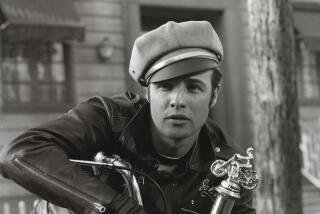Luther Vandross, 54; ‘Soul Balladeer’ Sang With Eloquence and Restraint
Luther Vandross, the Grammy-winning R&B; singer whose emotionally charged Top 40 love declarations remapped contemporary soul singing before his career was interrupted two years ago by a stroke, died Friday. He was 54.
Vandross died at John F. Kennedy Medical Center in Edison, N.J. The cause of death was not reported.
After an April 2003 stroke left him incapacitated, Vandross gave up most public appearances, although he had recovered enough to appear on “The Oprah Winfrey Show” a year later.
But he made a dramatic return to the public spotlight with his 2003 album “Dance With My Father,” which earned him four Grammy Awards, including song of the year for the bittersweet title track. The album gave him the first No. 1 album on the pop chart of his long career.
During last year’s Grammy ceremony, a video tribute to Vandross, featuring many of his peers dancing with their fathers as the song played, brought the music industry crowd to its feet. The highly emotional finale featured Vandross expressing his appreciation to fans for their support and to Grammy voters for the recognition. A month later, he was given four NAACP Image Awards.
“I asked him, just before he took sick, ‘What are you trying to do? Why are you working so hard?’ ” his mother, Mary Ida Vandross, recalled last year after the Grammy show. “I warned him, ‘You’re going to kill yourself.’ He said, ‘I want to give them the best that’s in me. I want them to hear it and see it.’ ”
“Luther Vandross had a peaceful passing under the watchful eye of friends, family and the medical support team,” according to a statement released Friday by the hospital.
“As you know, Luther Vandross suffered a stroke two years ago, which he never fully recovered from,” the statement said. “Throughout his illness, Luther received excellent medical care and attention from his medical team. Luther was deeply touched by all the thoughts and wishes from his fans.”
The Rev. Jesse Jackson, a friend of Vandross, on Friday described him as “a boy so mellow, so powerful; a boy of rare, rare vintage. We lost Luther very early because of his medical condition, but his legacy will be a powerful legacy.”
Vandross stood out in a crowded field of garden-variety pop balladeers, overproduced records and pat sentiments, distinguishing himself in the 1980s as a singer of eloquence and restraint.
With a cluster of hits -- including “Never Too Much,” “Here and Now,” “Power of Love/Love Power,” “Don’t Want to Be a Fool” and “Endless Love,” a duet with Mariah Carey, Vandross was considered one of the leading romantic singers of his generation.
Influenced by a cross-section of African American music styles from gospel to classic R&B;, and bridging the gap between classic soul and post-disco R&B;, the singer, songwriter and producer broadened the definition of contemporary soul singing.
He concentrated on coaxing the emotion out of a song, stretching a line or fragment of verse. He repeated a word until he breathed new meaning into it.
With his wide vocal range and production acumen, Vandross quickly became a pacesetter, paving the way for a new generation of male singers, including Babyface and Freddie Jackson, laying bare their emotions in a sensitive manner.
“I think Luther is like Frank Sinatra, in that he’s got this 18-karat gold depression in his voice,” said author and music historian David Ritz.
“A haunting loneliness. He’s an archetypal soul balladeer. The very top. He had this kind of cry in his voice which is penetrating.
“Very few people had it. Marvin [Gaye] had it, Sam Cooke had it,” Ritz said.
Luther Ronzoni Vandross was born in New York in 1951, the youngest of four children. His mother was a practical nurse and his father, Luther Vandross, an upholsterer who died of diabetes when the younger Luther was 8.
The household was steeped in music -- gospel, doo-wop, soul. His sister Pat was a member of the doo-wop group the Crests, who scored a 1958 hit with “16 Candles,” and Vandross exhibited a natural affinity for song. His mother fed his interest and encouraged his musical education.
It soon became the only thing he was interested in studying. As a high school student, Vandross obsessed over female singers: Aretha Franklin, Dionne Warwick, the Shirelles and particularly the high-concept Motown ensembles, including the Supremes.
“It was the women who drew me to the stereo,” Vandross said in a 1990 interview. “Men feel they have something to prove. They don’t trust their automatic-pilot chops. Females do. They go on deeper dramatic trips, take more chances. Put it out there with greater flair.”
Vandross’ grades dropped as his musician’s ear and intuition sharpened. He formed his own group while in school and became part of a musical workshop called Listen My Brother. He had his first big break when his composition “Everybody Rejoice (A Brand New Day)” was used for the theater production, and later the film, “The Wiz.” And though he enrolled at Western Michigan University, it was clear that music would take center stage.
In 1974, a former workshop associate, guitarist Carlos Alomar, who had become David Bowie’s guitarist, pulled Vandross in as a backup singer in session work for Bowie’s 1974 soul-flavored album “Young Americans.” After hearing some of Vandross’ ideas, Bowie tapped him to do much of the vocal arranging as well as singing backup. He also included one of Vandross’ compositions, “Fascination,” on the album.
Vandross also toured as a backup singer with Bowie, and the rock star introduced him to Bette Midler, who hired him to sing on her next two albums. By then, Vandross was a hot commodity on the recording circuit, adding his vocal fills and innovative ideas to many songs’ and shows’ arrangements. His session credits included Chaka Khan, Ringo Starr, Barbra Streisand, Carly Simon, Average White Band and Donna Summer.
While session work and commercial jingle opportunities abounded -- over the years, he did spots for Kentucky Fried Chicken and the U.S. Army -- a solo career eluded him. In 1975, there was a brief foray in a vocal group called Luther, which included musicians Nile Rodgers and Bernard Edwards, who later formed the group Chic.
After they released two records to lukewarm response in 1976, Vandross returned to session work, engraving his distinctive mark on a range of projects with Quincy Jones, Patti Austin, Gwen Guthrie, Chic and Sister Sledge.
Part of the difficulty in landing the right recording contract stemmed from his insistence on total creative control. By 1980, he had sunk much of his income into his own studio, where he recorded tracks that became “Never Too Much,” his 1981 solo album debut for Epic. It reached No. 1 on the R&B; charts and the Top 20 on the pop charts.
He had platinum or multi-platinum success through that decade with albums that included “Forever, for Always, for Love” (1982), “Busy Body” (1983), “The Night I Fell in Love” (1985), “Give Me the Reason” (1986) and “Any Love” (1988). But it wasn’t until 1989 that Vandross registered his first Top 10 single, “Here and Now.” The hits continued through the first half of the ‘90s and resumed through his final album.
Along with the success came dramatic -- and high-profile -- weight gains and losses. At 6 feet, 3 inches, he fluctuated between 190 and 340 pounds. The singer, who was single, attributed the swings to a rocky love life and his “overmedicating” with food. He also had mild diabetes.
In 1986, Vandross made headlines after an automobile accident in which one passenger was killed and another was injured. He was charged with vehicular manslaughter; the charge was later dropped in exchange for a no-contest plea to reckless driving and an agreement to hold a benefit for the victim, his friend, Lawrence Salvemini.
Such sobriquets as “master of bedroom music” troubled Vandross, who wanted to be remembered as a singer, not as a “ladies only” act. “I consider my music to be universal,” Vandross said in one interview. “My music is based solely on feelings, not analysis.”
Vandross released a self-titled album on Clive Davis’ J Records label in 2001 that was considered a return to form. It contained his first Top 40 hit, “Take You Out,” since his duet with Carey in 1994.
He is survived by his mother.
*
Times staff writer Randy Lewis contributed to this report.
More to Read
The biggest entertainment stories
Get our big stories about Hollywood, film, television, music, arts, culture and more right in your inbox as soon as they publish.
You may occasionally receive promotional content from the Los Angeles Times.










